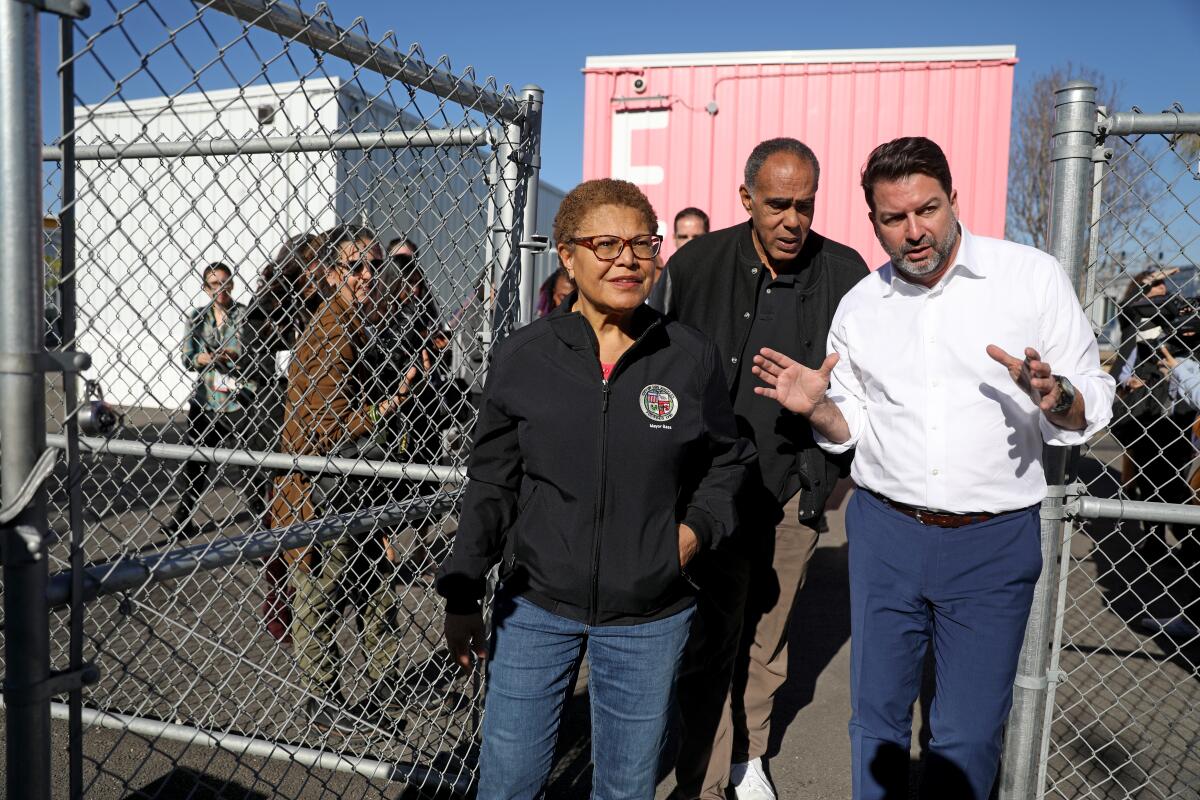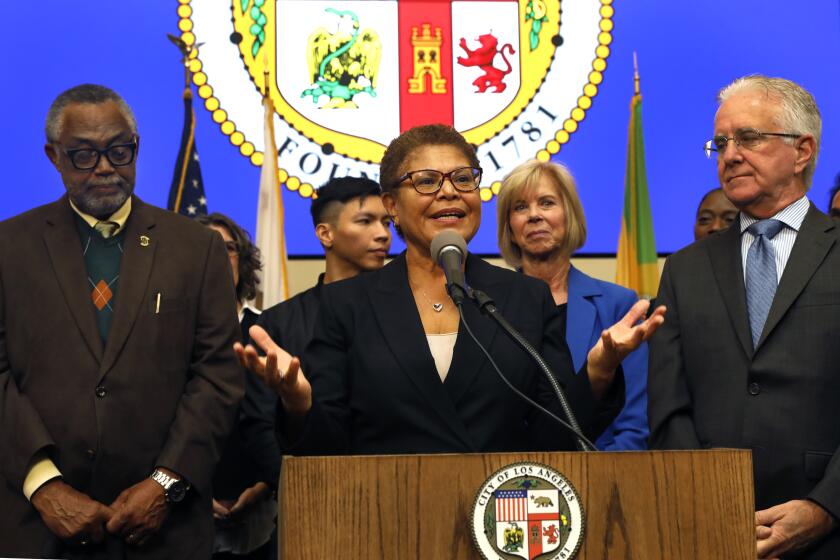Mayor Bass orders list of vacant city properties where homeless housing could be built

- Share via
Los Angeles Mayor Karen Bass ordered city officials on Friday to prepare a list of the city’s surplus and unused properties over the next three weeks, the first major step in identifying which ones will be used for building homeless housing.
Bass, in her third executive directive on homelessness since taking office in December, said she wants city officials to vet each of those sites by March 31 to determine which would work best for temporary or permanent housing — an aggressive timetable for a city that has been struggling for years to respond to the crisis.
The mayor intends to seek similar information over the coming months from the city’s three proprietary agencies — the Port of Los Angeles, Los Angeles World Airports and the Department of Water and Power — which may face some restrictions on how their property is used. She also will seek to build on sites owned by the L.A. County Metropolitan Transportation Authority, where she controls four of 13 board seats.
“We’ve already had significant and very promising discussions with Metro about setting sizable amounts of land aside for use of permanent housing, for interim housing and affordable housing in general,” said Mercedes Marquez, the mayor’s chief of housing and homelessness solutions. “Those discussions are already commenced and moving forward in a very positive way.”
Weeks into her tenure as Los Angeles mayor, Karen Bass talks about her focus on homelessness and affordable housing.
The mayor, who has promised to bring 17,000 people indoors in her first year, issued her order one week after the City Council voted to allow a new 168-room hotel to go up on a longtime redevelopment site near USC — one whose development was negotiated by the city.
Opponents of the hotel, which is planned on land once occupied by a city library, said such publicly owned property should have been reserved for affordable housing. They are still hoping Bass will intervene.
“We think the mayor should do everything she can to uphold the spirit of her directive and make sure that affordable housing is built at this location,” said Maria Patiño Gutierrez, director of equitable development for land use at the nonprofit Strategic Actions for a Just Economy.
Bass spokesperson Zach Seidl said the mayor does not currently have a position on the hotel.
Councilmember Marqueece Harris-Dawson, who represents the area where that site is located, spoke in favor of that project last month, telling his colleagues it has been in the works for several years — and would provide his South L.A. district with its first unionized hotel and other community benefits.
“[This is] the very rare occasion that I will stand up in defense of a private developer, a private commercial developer, over affordable housing,” he said at the time.
Friday’s order is the latest in a series of efforts by the mayor to confront homelessness quickly and aggressively. Since mid-December, her Inside Safe initiative has moved more than 200 people living on the streets of Venice, Del Rey, Hollywood and parts of South Los Angeles into temporary housing. She is only the latest elected official at City Hall to scope out publicly owned land for homeless housing.
Last year, former City Controller Ron Galperin released a report identifying 26 vacant city properties as potential sites for shelters or affordable housing, including public parking lots in Lincoln Heights, Leimert Park and Reseda.
Galperin’s list also included the Parker Center site, which once served as the LAPD’s headquarters, as well as the property known as Marlton Square near Crenshaw Boulevard in South L.A., which has long been eyed for private commercial development.
Aides to Bass say the upcoming analysis will be more comprehensive than the one carried out last year, offering a “deeper look” at the city’s vacant or surplus land.

Bass has spent several weeks visiting publicly owned homeless housing developments, frequently with federal officials in tow. On Wednesday, she and Jeff Olivet, executive director of the U.S. Interagency Council on Homelessness, visited Hilda L. Solis Care First Village, a homeless housing complex built on county-owned land once reserved for a jail facility.
A day later, officials in the San Fernando Valley celebrated the completion of the city’s 11th “tiny home” facility, which occupies public right-of-way that runs along Metrolink railroad tracks.
Get the lowdown on L.A. politics
Sign up for our L.A. City Hall newsletter to get weekly insights, scoops and analysis.
You may occasionally receive promotional content from the Los Angeles Times.
Marquez, the mayor’s homelessness czar, said the planned projects could be built using modular components. She dismissed the idea of putting tiny homes on those city properties, saying she is focused on construction of long-term units with their own kitchens and bathrooms.
“I’m not looking at building shelters,” she added.
In recent years, some of the city’s efforts to explore publicly owned land for homeless facilities have been met with a backlash.
Two years ago, then-Councilmember Mike Bonin asked city policy analysts to examine whether temporary homeless facilities could be constructed on or next to park and recreation facilities in his district, including Dockweiler Beach in Playa del Rey and Will Rogers State Beach in Pacific Palisades. That request drew opposition from an array of neighborhood leaders.
City officials eventually issued a four-page report labeling a majority of those locations as infeasible, largely because they lacked sufficient infrastructure or were already heavily used by families for park and recreation activities.
Marquez said Bass has no intention of putting homeless facilities on parks or recreation sites.
More to Read
Sign up for Essential California
The most important California stories and recommendations in your inbox every morning.
You may occasionally receive promotional content from the Los Angeles Times.















